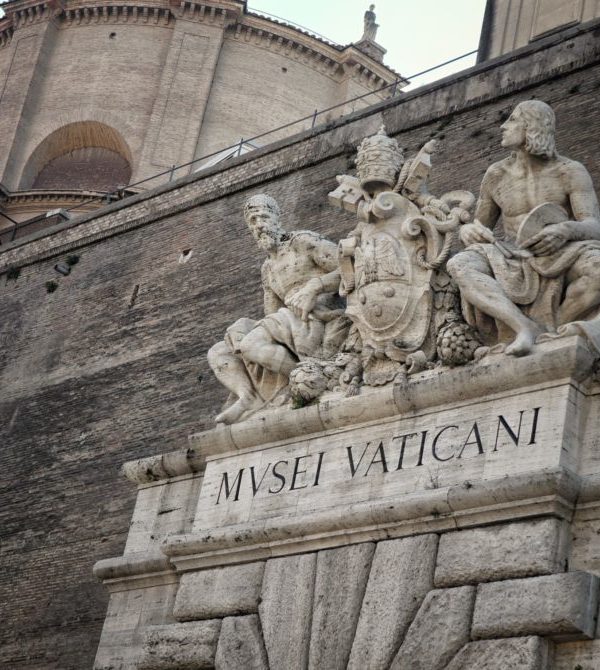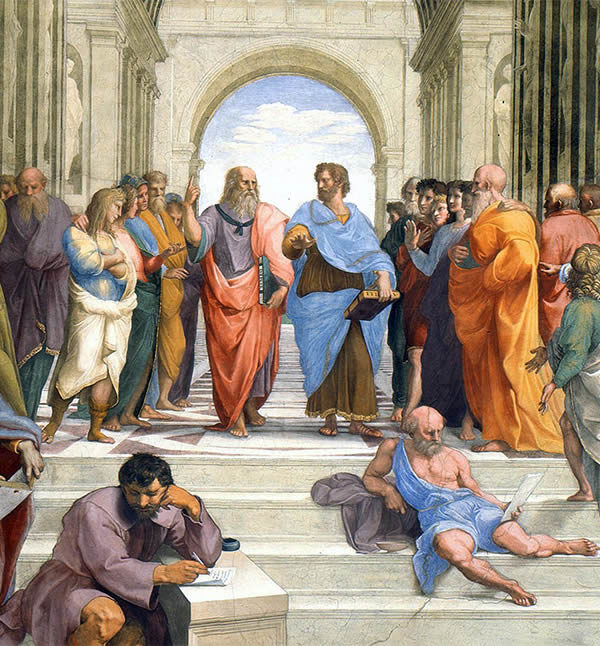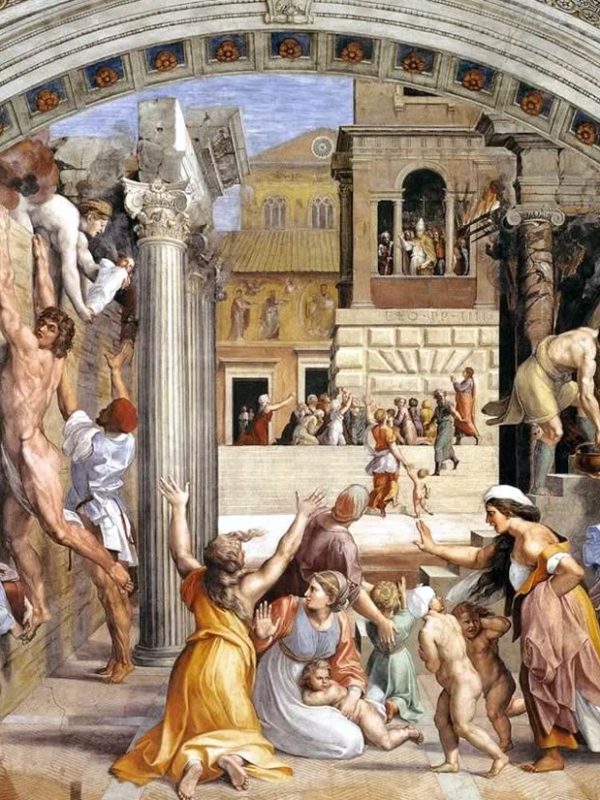The Pinacoteca building, completed in 1931, was commissioned by Pope Pius XI (1922-1939) to reorder a collection of paintings, already belonging to several popes, started by Pius VI (1775-1799). Many of the paintings on display were transported to Paris by Napoleon in 1797, but were later returned following the Congress of Vienna (1815) also for the intercession of the sculptor Antonio Canova.
The works, ranging from the Middle Ages to the 1800s, are exhibited in chronological order in eighteen rooms.
– Room I – There are collected works of painters of the XII-XIII and XIV century, called “primitive” because they preceded Giotto. The paintings on a wooden panel are generally characterized by a golden background, figures with clean outlines and uniform colors, lack of perspective in the architectural elements. The main figure is often represented in the center, while the stories of his life are illustrated on the sides.
– Room II – It is dedicated to the Sienese painters of the fourteenth century and Giotto (1267-1337), the greatest Italian artist of the Middle Ages. Noteworthy: “Jesus before Pilate” by Pietro Lorenzetti (1280 / 1285-1348) in which the extreme refinement and elegance of painting, characteristic of the painters of this city, is expressed in sinuous forms and warm colors; the “Blessing Redeemer” by Simone Martini (1284-1344). In the center is Giotto’s “Triptych” called “Stefaneschi”, from the name of the client. Painted on both sides, it depicts on the central panel Saint Peter on the throne with angels and offerers on the recto and Christ on the throne with angels and offerer (cardinal Stefaneschi) on the reverse. Note the refined mosaic decorations of the throne.
– Room III – There are exhibited works by artists of the early fifteenth century, a period in which there was the transition to the new painting in the city of Florence: the golden background tends to disappear, the figures become increasingly solid, the central perspective has a single point of escape in which the straight lines that indicate the depth converge.
Of great beauty is the small tempera on panel of the “Madonna and Child, Saint Dominic and Saint Catherine” by the Dominican friar Beato Angelico; here the new pictorial theories go perfectly with the love for the typical miniature of the Middle Ages.
– Room IV – In this room there are works by the Emilian painter Melozzo da Forlì (1438-1494): the “Musician Angels” are fragments of a vast fresco that covered the apsidal basin of the church of the Holy Apostles at Piazza Venezia and depicted “Christ in glory between angels and apostles “: the figures with bold glimpses, serene faces and airy hair are often reproduced in the music history texts.
Another detached fresco, the work of Melozzo, is “Sixtus IV and Platina” (1477) which depicts Platina’s appointment as prefect of the Apostolic Library and portrays Giuliano della Rovere, the future Julius II, in a cardinal habit. All the characters are inserted within an architecture strictly in perspective, with the classic motifs of the coffered ceilings adorned with rosettes, golden moldings and with oak garlands (Sixtus IV also belonged to the Rovere family).
– Room V – It is still dedicated to 15th century painting. In the painting “Miracles of San Vincenzo Ferrer” by Ercole de ’Roberti (circa 1450-1496) one finds a typical theme of Italian painting of this century: the taste for ancient ruins and the architecture of the past.
– Room VI – Contains polyptychs of Italian artists of the fifteenth century often still tied to the fourteenth century ways (golden background, attention to detail).
– Room VII – Collects works from the Umbrian pictorial school, including the “Virgin and Child with Four Saints” by Perugino (1446-1524), completed in 1495, in which the artist composes the subjects in calm and balanced poses, inserting them within an architectural space in turn immersed in a gentle and serene landscape. The artist had already painted the “Handing over the keys” (1461) in the Sistine Chapel. Note the “Saint Jerome Enthroned” by Giovanni Santi (? -1494), father of the great Raphael.
– Room VIII – It exhibits on the walls a tapestry of the Last Supper taken from the work of Leonardo da Vinci (1452-1519) and Flemish tapestries of the 16th century on cartoons by Raphael (1483-1520): the latter were first placed inside of the Sistine Chapel, in the lower part of the walls.
In the center of the room there are works by Raphael: on the right the “Coronation of the Virgin” of 1502-1503, belonging to the youth phase; on the left the “Madonna di Foligno” (1511-1512), contemporary with the work phase in the apartment of Julius II known as the “Rooms”; in the center, the masterpiece of the “Transfiguration” (1518-1520), executed in oil on wood, in which the artist shows that he is under the influence of Michelangelo in the drama of the figures.
– Room IX – Contains an unfinished work by Leonardo: the famous “San Girolamo” from 1482; note, in the upper left, the typically Leonardo landscape, made up of glaciers and remote mountains, as well as the emaciated figure of the Saint who, having abandoned all his earthly possessions, embraces the ascetic life. In the room there is also the “Lamentation over the dead Christ” by the Venetian painter Giovanni Bellini (1430-1516).
– Room X – Contains works executed by some of the greatest painters of the sixteenth century Veneto: to Titian (1490-1576) belongs the “Madonna di San Niccolò dei Frari” with the beautiful veiled woman on the right, while it is by Paolo Caliari known as Veronese ( 1528-1588) a painting representing “Sant’Elena”: taken from below, it is interpreted according to a typical typology of the artist, like a rich woman dressed in a large shimmering brocade dress.
– Room XI – Works by painters of the second half of the sixteenth century are on display, including the “Lapidation of Santo Stefano” by Giorgio Vasari (1511-1574), the “Sacrifice of Isaac” by Ludovico Carracci, the “Annunciation” by Cavalier d’Arpino, dated 1606, and Barocci’s “Rest on the Flight into Egypt” (1528-1612).
– Room XII – It is dedicated to the painters of the early seventeenth century, who inherited the taste for realism and daring glimpses from Caravaggio; of particular interest are the “Communion of Saint Jerome” painted by Domenichino in 1616, the “Crucifixion of Saint Peter” and “Saint Matthew and the angel” by Guido Reni (1575-1642), “Saint Peter who denies Christ” by Caravaggesque school, the “Deposition from the cross” by Caravaggio in 1604 and the “Martyrdom of Saint Erasmus” by the French painter Nicolas Poussin.
– Rooms XIII, XIV and XV – In the first room there are paintings by the Flemish Van Dyck, the Italian Pietro da Cortona and the French Nicolas Poussin, while in the rooms XIV and XV there are paintings of “genre” from the 1600s and 1700s.
– Room XVI – It houses paintings by the Bohemian painter Wenzel Peter (1745-1829), born near Prague: the superb “Adam and Eve in Paradise on Earth” with an exceptional variety of flowers and animals is worth mentioning. The two adjoining rooms display clay models of statues by Gian Lorenzo Bernini, made for works in the Basilica of San Pietro (room XVII), and Greek icons from the XV to the XIX century (room XVIII).



